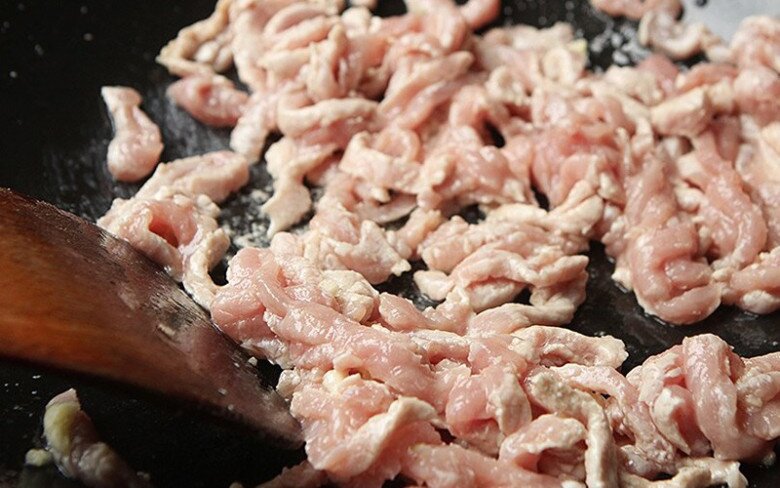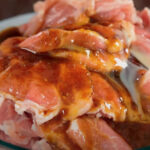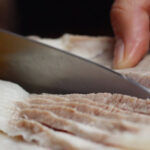The key to stir-frying meat that is both delicious and tender lies in the way it is cut, marinated, and cooked – steps that may seem simple but are crucial to the quality of the dish. In this article, we will share with you some tips for stir-frying pork to perfection, from preparation to cooking. Let’s explore and apply these tips to elevate your cooking skills!
Cut Against the Grain, Medium-Sized Pieces
Cutting the meat is the first and most important step. Whether it’s beef or pork, always cut against the grain for stir-frying to prevent the meat from becoming tough and chewy. If you don’t pay attention to this step, even if the rest of the steps are followed correctly, the stir-fried meat may not turn out perfectly.
For stir-fried dishes, it is best to cut the meat into thin strips, about the size of a chopstick. This size not only helps the meat cook quickly but also retains moisture, keeping it tender and more appetizing.

Don’t Marinate with Salt Before Stir-Frying
A common mistake when marinating meat is to add salt at the beginning. This causes the meat to lose its natural moisture, becoming dry and tough after stir-frying. Instead of using salt, marinate the meat with other seasonings such as soy sauce, cooking wine, and a little cornstarch. These ingredients not only tenderize the meat but also eliminate any fishy odor, enhancing its flavor and making it more appealing.
Marination: Add Cornstarch and Egg White
If you want your stir-fried meat to be tender and naturally sweet, don’t forget these two special ingredients: cornstarch and egg white.
– Cornstarch: Helps retain moisture in the meat, preventing it from drying out during stir-frying.
– Egg White: Coats the meat with a thin layer, making it softer and smoother.
Marination Method:
– Add cooking wine to the cut-up meat.
– Mix in light soy sauce and a teaspoon of cornstarch.
– Finally, add the egg white, mix well, and marinate for about 20 minutes.

Apply the “Hot Wok, Cold Oil” Principle
The proper stir-frying technique will help keep the meat tender and fresh. Instead of heating the oil until it smokes and then adding the meat, use the “hot wok, cold oil” method.
Instructions:
– Heat the wok first, then add oil and heat until hot.
– Discard this oil and add fresh, cold oil (oil that hasn’t been heated) to the wok.
– Immediately add the meat to the wok and stir-fry.
This method not only prevents the meat from sticking to the wok (especially with a regular wok) but also helps retain its tenderness and moisture.

Finalizing the Stir-Fried Pork Tenderloin
When the meat is cooked, remove it from the wok and set it aside. Use the same wok to cook the other ingredients. When they are almost done, add the stir-fried meat back in, adjust the seasoning, and mix well before turning off the heat.
A well-prepared stir-fried pork dish should not only be delicious but also retain its tenderness, juiciness, and harmonious blend of flavors. With these tips, you’ll surely impress even the most discerning diners!
The Ultimate Guide to Avoiding Meat Preparation Pitfalls
“Mistakes to Avoid When Cooking Meat: A Guide for Home Cooks”.
Many home cooks, especially those new to the kitchen, often make common mistakes when it comes to cooking meat. From adding cold water to a pot of boiling meat to defrosting meat with hot water, these mistakes can ruin a dish. This introduction aims to highlight these errors and provide a preview of the article, which will offer valuable insights to help readers avoid these pitfalls and elevate their meat-cooking game.
“The Ultimate Guide to Speedy and Easy Food Chopping”
“Even the most experienced home cooks can fall victim to the occasional kitchen mishap, such as a nasty knife cut or a tough, chewy steak. But fear not, with a few simple tips and tricks, you can easily master the art of food preparation and say goodbye to kitchen catastrophes. Learn how to effortlessly slice through even the toughest meats and discover the secrets to a perfect, tender bite every time. It’s time to elevate your culinary game and become a master chef in your own right.”




































